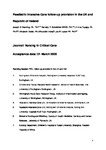Paediatric Intensive Care follow-up provision in the UK and Republic of Ireland
| dc.contributor.author | Manning, J | |
| dc.contributor.author | Scholefield, B | |
| dc.contributor.author | Popejoy, E | |
| dc.contributor.author | Dodds, E | |
| dc.contributor.author | Latour, Jos M | |
| dc.date.accessioned | 2020-04-01T08:28:16Z | |
| dc.date.issued | 2020-04-23 | |
| dc.identifier.issn | 1362-1017 | |
| dc.identifier.issn | 1478-5153 | |
| dc.identifier.uri | http://hdl.handle.net/10026.1/15483 | |
| dc.description.abstract |
<jats:title>Abstract</jats:title><jats:p>The objective of this study was to examine the characteristic, content, and role of Paediatric Intensive Care Units (PICUs) in the provision of follow‐up for children and their families' post‐intensive care discharge in the United Kingdom (UK) and Republic of Ireland (RoI). The study followed a descriptive self‐reported, web‐based survey design. “In‐hospital PICU follow‐up” was defined as follow‐up delivered by the PICU team following PICU discharge but before hospital discharge and “post‐discharge PICU follow‐up” was defined as follow‐up delivered by the PICU team following hospital discharge. The survey was administered to all 28 PICUs in the UK and RoI. Paediatric intensive care medical directors or delegated individuals participated. Data were collected between September 2017 and January 2018 with a response rate of 79% (n = 22/28). Twelve units provided either in‐hospital and/or post‐discharge PICU follow‐up. Ten (45%) PICUs reported providing in‐hospital follow‐up, with half (n = 5) using an eligibility criteria for in‐hospital follow‐up, which related to disease groups. The most frequently reported form of in‐hospital PICU follow‐up consisted of face‐to‐face patient consultation (n = 8) by a PICU doctor (n = 5) and/or nurse (n = 4). The time at which initial contact was made was usually not predetermined (n = 4) and the assessment of care needs included are tracheostomy care (n = 4), respiratory care (n = 4), and sedative medication weaning plan (n = 5). Four PICUs reported to provide post‐discharge follow‐up. This involved telephone (n = 2), follow‐up clinic consultations (n = 1) or home visits (n = 1), provided predominantly by PICU doctors (n = 2), with their activity directed by patient needs (n = 3). Despite increasing evidence to suggest PICU survivors and their families experience negative sequalae post‐PICU discharge, less than half of PICUs surveyed provide in‐hospital follow‐up and only a minority provide post‐discharge follow‐up. There is variation in the delivery, content, and format of in‐hospital and post‐discharge PICU follow‐up in the UK and RoI.</jats:p> | |
| dc.format.extent | 128-134 | |
| dc.format.medium | Print-Electronic | |
| dc.language | en | |
| dc.language.iso | en | |
| dc.publisher | Wiley | |
| dc.subject | follow-up | |
| dc.subject | paediatric intensive care | |
| dc.subject | post-intensive care syndrome paediatrics | |
| dc.subject | survey | |
| dc.title | Paediatric Intensive Care follow-up provision in the UK and Republic of Ireland | |
| dc.type | journal-article | |
| dc.type | Journal Article | |
| dc.type | Research Support, Non-U.S. Gov't | |
| plymouth.author-url | https://www.webofscience.com/api/gateway?GWVersion=2&SrcApp=PARTNER_APP&SrcAuth=LinksAMR&KeyUT=WOS:000527872500001&DestLinkType=FullRecord&DestApp=ALL_WOS&UsrCustomerID=11bb513d99f797142bcfeffcc58ea008 | |
| plymouth.issue | 2 | |
| plymouth.volume | 26 | |
| plymouth.publication-status | Published | |
| plymouth.journal | Nursing in Critical Care | |
| dc.identifier.doi | 10.1111/nicc.12510 | |
| plymouth.organisational-group | /Plymouth | |
| plymouth.organisational-group | /Plymouth/Faculty of Health | |
| plymouth.organisational-group | /Plymouth/Faculty of Health/School of Nursing and Midwifery | |
| plymouth.organisational-group | /Plymouth/REF 2021 Researchers by UoA | |
| plymouth.organisational-group | /Plymouth/REF 2021 Researchers by UoA/UoA03 Allied Health Professions, Dentistry, Nursing and Pharmacy | |
| plymouth.organisational-group | /Plymouth/Research Groups | |
| plymouth.organisational-group | /Plymouth/Research Groups/Institute of Health and Community | |
| plymouth.organisational-group | /Plymouth/Research Groups/Plymouth Institute of Health and Care Research (PIHR) | |
| plymouth.organisational-group | /Plymouth/Users by role | |
| plymouth.organisational-group | /Plymouth/Users by role/Academics | |
| dc.publisher.place | England | |
| dcterms.dateAccepted | 2020-03-31 | |
| dc.rights.embargodate | 2021-4-23 | |
| dc.identifier.eissn | 1478-5153 | |
| dc.rights.embargoperiod | Not known | |
| rioxxterms.versionofrecord | 10.1111/nicc.12510 | |
| rioxxterms.licenseref.uri | http://www.rioxx.net/licenses/all-rights-reserved | |
| rioxxterms.licenseref.startdate | 2020-04-23 | |
| rioxxterms.type | Journal Article/Review |


